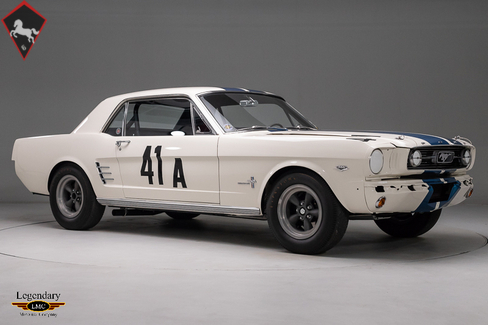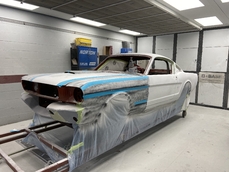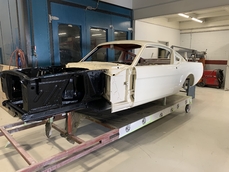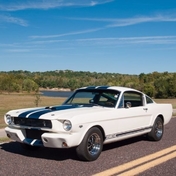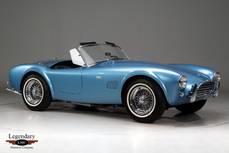Shelby GT 350 Mustang Group II Racer 1966
General description :
Originally Built For Famous Legendary Shelby American Driver; Ken Miles
#12 of 16 Shelby Group II Racers Factory Built In 1966
Purchased New By John McComb And Raced From 1966-1969
1st Place At Pan American Trans-Am, Green Valley, TX In 1966
1st Place At Continental Divide SCCA National In 1966
John McComb And This Car Helped Ford Claim The Trans Am Manufacturers Championship For 1966
Featured on the December 1966 cover of Sports Car Graphic
Participant in the 24 Hours of Daytona, 1967
Finished 2nd in 1967 SCCA A/Sedan Midwest
Complete Rotisserie Restoration By Legendary Motorcar
LMC is very proud to offer for sale this 1966 Shelby Group II Racer
There’s no telling how Ken Miles would have helped Shelby and Ford in the 1966 SCCA Trans-Am series; he died in August of that year without having driven this Shelby Mustang that was factory prepared for him. Yet John McComb made the best of a tragic situation by racing this Mustang to two wins and helping Ford clinch the manufacturers’ championship that year.
McComb began racing in SCCA in 1963, but didn’t enter more than a handful of races until 1965, when he qualified for the national championship in an MGB. Through that experience, he met fellow MGB racer Chuck Cantwell, who got hired at Shelby American in 1964 and a couple of years later was tasked with transforming the Mustang notchback into a Trans-Am racer. According to SCCA rules, the Mustang fastbacks – which, of course, Shelby based his G.T. 350 upon – were classified as two-seaters, leaving them ineligible for Trans-Am’s A/Sedan class (which also specified that entrants have all-steel bodywork and no hood scoops). Regardless, Ford wanted a "horse” in the Trans-Am race, so Cantwell built 16 notchback K-code Mustangs with G.T. 350R underpinnings (along with another four with street G.T. 350 underpinnings built for European FIA rallying) and stripped them of every non-essential item the rule book would allow him to get away with. The equipment included a Shelby-built 289 CI engine with an aluminum high-rise intake manifold and 715 CFM Holley 4-barrel carburetor, Borg-Warner close ratio 4-speed, Detroit Locker rear end, high-capacity fuel tank with quick-release filler, heavy duty front disc and rear drum brakes, Koni shock absorbers, heavy duty oil cooler and radiator, 15x7 American Racing wheels and more. Shelby, which had dissolved its factory racing effort at the end of 1965, sold the cars as Ford Mustangs to privateer customers.
This 1966 Ford Mustang Group II A/Sedan racer is number 12 of 16 built by Shelby American to compete in the SCCA Group II amateur racing series created in concert with the professional Trans Am series. Invoiced August 24, 1966 to Turner Ford in Wichita, Kansas, this car was purchased by John McComb. When McComb put in a request for one of the Trans-Am Mustangs with his friend Cantwell, all 16 had been spoken for; it wasn’t until after Ken Miles death in August 1966 while testing a Ford GT40 J-car at Riverside that Cantwell called up McComb to let him know that one of the Mustangs had become available. McComb, who was based in Hutchinson, Kansas, at the time, said he picked up the Mustang in Los Angeles and within two weeks won two races – at Continental Divide in Castle Rock, Colorado, and at Green Valley Raceway outside Fort Worth, Texas, the latter tying Ford with Chrysler for the lead in the manufacturers’ championship. In 1966 this was with the help of this very car, that Ford would go on to claim the overall title. It also appeared on the December 1966 cover of Sports Car Graphic Magazine. It was purchased by Keith Thomas in June of 1967, who finished second in the 1967 SCCA A/Sedan Midwest Region behind McComb. The following year it set the A/Sedan lap record at the Lake Afton SCCA National. It eventually disappeared for 28 years until it was discovered in a Texas garage.
It was then brought to Legendary Motorcar where it received a no-expense spared rotisserie restoration. The car was carefully disassembled, stripped to bare metal and refinished in its factory Wimbledon White with Lemans Blue stripes. The goal was to restore back to its period correct racing glory, while also being able to be shown at any major concours. The result is stunning with attention to detail to reproduce the factory markings, correct numbering and paint methods. The car is also signed by the man himself Carroll Shelby as well as John McComb, Chuck Cantwell and Terry Doty.
Below is the link to complete photo album of the restoration:
https://www.legendarymotorcar.com/inventory/1966-ford-mustang-shelby-trans-am-group-ii-racecar-1165.aspx
http://www.legendarymotorcar.com/inventory/1966-shelby-ford-mustang-group-ii-racer-2128.aspx
1966 Shelby GT 350 Mustang Group II Racer is listed sold on ClassicDigest in Halton Hills by Legendary Motorcar for Not priced.
Car Facts
Car type : Car Make : Shelby Model : GT 350 Model Version : Mustang Group II Racer Engine size : 0.0 Model Year : 1966 Sub type : Race/Rally Car Location : Halton Hills
Sold
Seller Information
Sold
People who viewed this Shelby GT 350 also viewed similar Shelby listed at ClassicDigest
Other cars listed for sale by this dealer
About Shelby
Carroll Shelby, a legendary figure in the automotive world, had a remarkable journey from being a successful race car driver to becoming a renowned sports car manufacturer in the United States. His story is filled with achievements, innovations, and iconic cars that left an indelible mark on the industry.Early Years and Racing Career:
Carroll Shelby was born in 1923 in Texas. He initially pursued a career as a pilot during World War II but found his true passion in racing after the war. Shelby became a successful race car driver in the 1950s, competing in various events including Formula One, endurance racing, and the famous 24 Hours of Le Mans.
Shelby Cobras - Iconic Sports Cars:
Carroll Shelby's pivotal moment as a manufacturer came with the creation of the Shelby Cobra, an iconic American sports car. The Cobra was born from the fusion of a British AC Ace chassis and a Ford V8 engine, creating a lightweight, high-performance car that dominated tracks and streets alike. Key models include:
Shelby Cobra 260 (1962): The initial version with a 260 cubic inch (4.2L) V8 engine.
Shelby Cobra 289 (1963-1965): Later iterations with a 289 cubic inch (4.7L) V8 engine, including the competition-spec Cobras known for their racing prowess.
Shelby Cobra 427 (1965-1967): The most powerful iteration with a 427 cubic inch (7.0L) V8 engine, known for its raw power and performance.
Ford Partnership - Shelby Mustangs:
Shelby's partnership with Ford led to the creation of legendary Shelby Mustangs. The most notable model is:
Shelby GT350 (1965-1969): Based on the Ford Mustang, the GT350 was modified by Shelby American, featuring enhanced performance, handling, and distinct styling.
Other Notable Models and Achievements:
Beyond the Cobras and Mustangs, Shelby had several other significant contributions:
Shelby Daytona Coupe: Created to win against Ferrari in international GT racing, this car became the first American car to win the FIA GT World Championship in 1965.
Shelby Series 1: Introduced in the late 1990s, this was Shelby's modern take on a high-performance sports car.
Ford GT40 plays a pivotal role in Carroll Shelby's narrative, especially in his connection to Ford and his significant contribution to the car's success.
The Ford GT40 Development:
Ford's Challenge:
In the early 1960s, Henry Ford II sought to acquire Ferrari, but negotiations fell apart. This spurred Ford's determination to beat Ferrari at the prestigious 24 Hours of Le Mans endurance race, which Ferrari had dominated for several years.
Collaboration with Shelby:
Ford turned to Carroll Shelby, recognizing his racing expertise and track record. Shelby was tasked with leading the GT40 project and turning it into a competitive race car capable of challenging Ferrari's supremacy.
Development and Triumph:
Under Shelby's guidance, the Ford GT40 underwent rigorous development to address initial design flaws and performance issues. Several iterations were produced:
Early Attempts: The initial versions of the GT40 faced reliability and handling issues, leading to disappointing results at Le Mans in 1964.
GT40 Mark II: Shelby's team made crucial improvements. The Mark II, equipped with a powerful V8 engine, improved aerodynamics, and refined engineering, became highly competitive.
Le Mans Victory:
In 1966, the Ford GT40 Mark II achieved a historic victory at the 24 Hours of Le Mans, with Shelby-coached driver Ken Miles leading the race. This marked the first win for an American manufacturer at Le Mans, breaking Ferrari's dominance.
Continued Success:
The GT40 continued to dominate, winning Le Mans for the following three years (1966-1969), securing its place in racing history and solidifying Ford's reputation as a force in international motorsport.
Shelby's Contribution to the GT40 Success:
While Carroll Shelby wasn't directly involved in designing the GT40, his expertise in racing and his ability to assemble and lead a team of talented engineers, mechanics, and drivers were instrumental in refining the car's performance. His influence helped address technical issues, refine the car's handling, and strategize race tactics, contributing significantly to the GT40's success on the track.
Legacy and Impact:
The Ford GT40's victories at Le Mans under Shelby's guidance remain one of the most iconic achievements in motorsport history. The car's success solidified Shelby's reputation as an automotive visionary and further strengthened his partnership with Ford.
Carroll Shelby's involvement in the GT40 project showcased his ability to transform a struggling project into a championship-winning machine, adding another remarkable chapter to his illustrious career in the automotive world.
